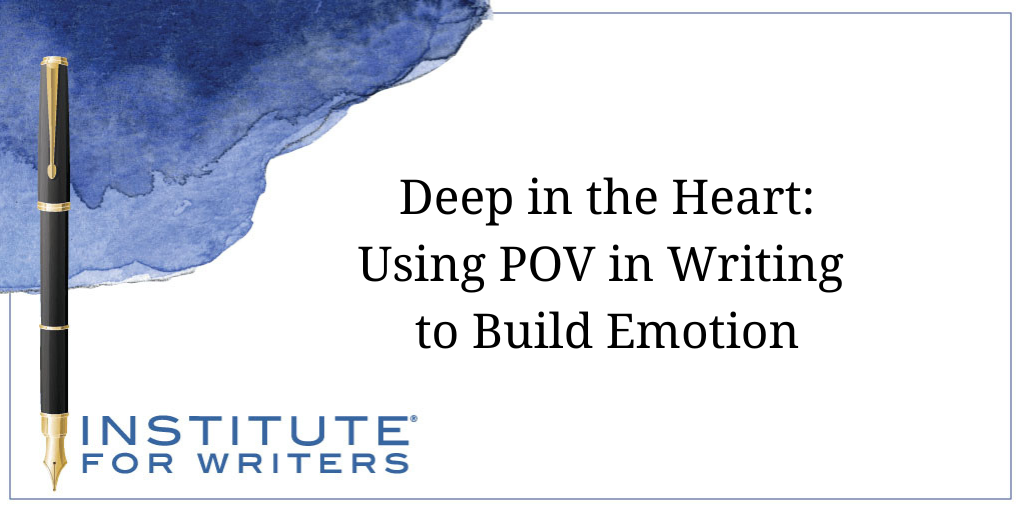
Influential Female Authors: Past, Present, and Rising
We’re going to look at influential female authors of the past, those impacting the present, and whom the industry expects to make a big splash.

Today we’re bringing you a sample of the resources you’ll receive when enroll in a writing course with IFW. Pointers from the Pros are 4-5 page articles written by our instructors that dive deep into a specific point about the craft of writing. If a certain element of your writing (or writing assignment) is tripping you up, as a student, you can download a related article to help you break through that particular block. Today’s Pointer from the Pros comes from former IFW instructor Jackie Diamond Hyman and offers tips for using POV in writing to build emotion. Find out more about our courses and submit your Writing Sample here!
Have you ever walked down a street the way an avatar moves through a video game, lacking memories or opinions about what you’re seeing?
Do you rely only on your vision and hearing, without any awareness of smell, touch, or taste?
Have you ever, during a heated discussion with your spouse, noticed only your physical movements —nodding, smiling, crying—rather than your feelings?
Unless you suffer from a rare psychological disorder, the answer is no. The same should be true of your characters.
Yet novel and short story writers frequently create scenes from an external viewpoint, leaving the reader to watch from a distance as characters go through their paces. This not only deprives their fiction of excitement, but it also masks the personality of the characters, because each of us views events in an individual way that reveals a lot about who we are.
In the 21st century, we spend less time reading and more time watching entertainment on a visual spectrum that includes movies, streaming shows, web series, video games, and more. Except for the occasional voice-over narration, modern media rely on camera angles, dialogue, and body language to convey emotion.
Fiction writers don’t have actors at their disposal. We do, however, have a wonderful tool that these media lack: point of view.
POV in writing takes us deep inside a character’s thoughts and feelings, creating an intimate emotional connection. To achieve this, everything that happens must be filtered through the character’s perceptions.
Not just big emotional moments. Not just memories. Everything.
To see how this works, here’s a low-key moment from my novel The Would-Be Mommy, published by Harlequin American Romance. In this scene, hero Ian Martin goes downstairs in a hotel to meet his twin sister Anni, whom he hasn’t seen in months.

He gathered a few things and hurried downstairs. In the lobby, the adjacent elevator opened at the same time as his, and Anni exited, also carrying a small shopping bag.
As they hugged, Anni was sucking a peppermint.
The reader gets the basic facts, but no attitude toward them. Ian could be angry, bored, or impatient to get this over with.
Here’s the same moment filtered through Ian’s perceptions.
Anticipation quickening, he gathered a few things and hurried downstairs. In the lobby, he heard the ding of the adjacent elevator and turned to see Anni exiting at almost the same instant. Like him, she carried a small shopping bag.
Big hug. Paper rustled, and the scent of peppermint filled the air. Anni loved the stuff.
Nowhere does this second version say “he was delighted to see her,” but this is communicated, all the same. In addition, a close reading will reveal that we hear the ding of the elevator through his ears, and see Anni only when he turns toward her. Rather than being told about the peppermint, we smell it.
In order to filter everything through a character, you have to know him or her very well. Whether you’re writing in the first person (“I”) or third person (“he” or “she”), you can’t show the world through someone’s eyes if you view her as a stereotype.
A giveaway that the author isn’t deep inside his characters comes in the use of generic descriptions. “She was of average height.” “He was a typical accountant.”
Nobody thinks of himself this way.
Another challenge for an author is separating a viewpoint character from herself. If my heroine is a battle-hardened Marine, she won’t get rattled at the sight of a mouse, even if I would. If my hero is a nurse, he won’t shy from a bloody wound as I might.
Our personality, age, occupation, life history, and immediate situation shape what we notice and how we react to people and places. Walking down the street, someone hears a dog barking persistently inside a house. How does he or she react?
Further down the street, the person enters a café where people are sipping lattes and eating sandwiches. What draws his attention?
How would your character react to the barking dog? What would he or she notice in the restaurant?
Today’s commercial fiction, whether mainstream or genre, relies upon deep point of view. However, a gritty noirish thriller requires a different tone than a light romantic comedy, plus each writer develops her own voice. Thus, we may choose to get intimately inside character’s POV or keep the reader at a slight distance. Still, in either case, everything is filtered through your character’s perceptions.
Here’s a sample of a deep POV from my mystery Danger Music, published by Five Star.
I took a root beer from the fridge and a half-full bag of chips from the counter. On the way back, I left them on my printer stand and made a pit stop. The toilet is my favorite place to think. You sit and sag, and you don’t have to please anybody. It’s the way therapy ought to be but usually isn’t.
Can’t you just feel yourself inside the heroine’s mind and body, walking with her, thinking her thoughts, feeling what she feels?
By contrast, in my romantic comedy Kidnapped?, I chose to use third-person and keep a little more distance between the reader and my hero, a Las Vegas hitman. The book opens this way:
Hal “The Iceman” Smothers was given to grand romantic gestures.
So far they had netted him three wives—now of the ex variety—as well as one broken arm and a lawsuit. There was also an interesting scar on his left shoulder where a certain object of his affections had put a bullet through it.
She had been the wrong woman for him. He could see that now. They had all been the wrong woman. But this time, he would not fail.
Until now, true love had passed him by. But if he had to wrestle Cupid to the ground and blacken both of his eyes, he intended to nail the little pest once and for all.
In this instance, although the observations are filtered through Hal’s perspective, the reader retains some objectivity. She is thus able to share the author’s wry attitude toward the lovelorn hit man.
Some writers believe it’s easier to write in the omniscient or all-knowing viewpoint, which allows them to speak directly to the reader and dip into multiple viewpoints. But writing omniscient effectively isn’t easy at all, and it can be a fatal error in genre fiction such as mysteries, fantasy, and romance, where most readers will toss the book aside if they can’t identify with the protagonist.
Moreover, when using the omniscient, the author’s attitude should add something to the story. In my romantic comedy Cindy and the Fella, published by Harlequin, I chose omniscient POV in writing the introductory scene to emphasize the almost mythic qualities of my heroine, teacher Cindy McChad. Here, she is forced to deal with an ill-tempered dad who disrupts a softball game:
As to what happened next, the observers never did agree. Some said that Miss McChad sidestepped and stuck out her foot. Others claimed she leaped away in slow motion like a mystical Chinese kung fu warrior, and the man lost his balance and tripped from his own weight. Whatever the case might be, the man went sprawling. . . . When he peered up again, a breeze eddied around Miss McChad, raising a swirl of leaves. From the ground, it must have appeared almost supernatural, the way the many-hued bits flew around and around her.
In the next scene, having used omniscient to create an effect, I move deeply into Cindy’s POV, and remain there.
Other than in such brief scenes or in sophisticated literary writing, the omniscient viewpoint rarely works well in contemporary fiction.
Most errors in POV involve either writing externally or head-hopping. In external writing, as demonstrated in earlier samples, the author shows the characters going through the moves but keeps the reader on the outside.
In head-hopping, the viewpoint jumps back and forth like a tennis ball, revealing each character’s thoughts from moment to moment. While this method may offer immediate insight, it undercuts the reader’s connection with a viewpoint character because he has trouble identifying with anyone.
Don’t you, the author, need to know what everyone in the scene is thinking? Absolutely! Their attitudes and personalities will be reflected in everything they say and do. Through the viewpoint character’s eyes, we’ll be watching, listening, and reacting.
In short stories, it’s usually best to stick to a single viewpoint throughout, but if it seems vital to show more than one person’s perspective, a shift can be made at a logical point, such as a break between scenes. Novels are frequently narrated from more than one viewpoint, but again, it’s best to make the shift between scenes or chapters.
In the matter of viewpoint, there’s plenty of leeway for the individual author’s style. Experiment with your current story or novel. For instance, try writing the same scene twice, from different characters’ points of view, to see which has the most impact.
If you catch your main character describing himself as if from the outside—seeing himself smile, for instance—you’ve slipped. Get back into his head!
With practice, you can find a tone and level of intimacy that suits you. Whether from the extreme close-up of chick lit or the cooler distance of a noir mystery, live inside your character, and the world you’ve created will become real to the reader.
Jackie Diamond Hyman, who writes as Jacqueline Diamond and Jackie Hyman, has sold over 80 novels, including romances, mysteries and fantasy. In addition to Harlequin, her publishers have included St. Martin’s Press and William Morrow. Jackie is formerly an instructor for Institute For Writers, and a former Associated Press reporter and TV columnist in Los Angeles.

We’re going to look at influential female authors of the past, those impacting the present, and whom the industry expects to make a big splash.

This week, we’re focusing on how we as writers can create strong female characters that others will look up to, instead of harmful stereotypes.

Is your writing routine reaching its potential? Maybe it’s time to take another look so you can see what’s possible for your writing.
1000 N. West Street #1200, Wilmington, DE 19801
© 2024 Direct Learning Systems, Inc. All rights reserved.

1000 N. West Street #1200, Wilmington, DE 19801
© 2025 Direct Learning Systems, Inc. All rights reserved.

1000 N. West Street #1200, Wilmington, DE 19801
©2025 Direct Learning Systems, Inc. All rights reserved. Privacy Policy.
1 Comment